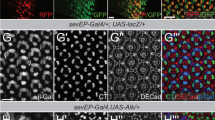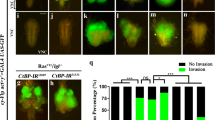Abstract
We previously showed that the Drosophila DNA binding homeodomain of Prospero included a 28 amino-acid sequence (HDA) that functions as a nuclear export signal. We describe here the identification of a protein we named Caliban, which can directly interact with the HDA. Caliban is homologous to human Sdccag1, which has been implicated in colon and lung cancer. Here we show that Caliban and Sdccag1 are mediators of nuclear export in fly and human cells, as interference RNA abrogates export of EYFP-HDA in normal fly and human lung cells. Caliban functions as a bipartite mediator nuclear export as the carboxy terminus binds HDA and the amino terminus itself functions as an NES, which directly binds the NES receptor Exportin. Finally, while non-cancerous lung cells have functional Sdccag1, five human lung carcinoma cell lines do not, even though Exportin still functions in these cells. Expression of fly Caliban in these human lung cancer cells restores EYFP-HDA nuclear export, reduces a cell's ability to form colonies on soft agar and reduces cell invasiveness. We suggest that Sdccag1 inactivation contributes to the transformed state of human lung cancer cells and that Caliban should be considered a candidate for use in lung cancer gene therapy.
This is a preview of subscription content, access via your institution
Access options
Subscribe to this journal
Receive 50 print issues and online access
$259.00 per year
only $5.18 per issue
Buy this article
- Purchase on Springer Link
- Instant access to full article PDF
Prices may be subject to local taxes which are calculated during checkout





Similar content being viewed by others
References
Bi X, Kajava AV, Jones T, Demidenko ZN and Mortin MA . (2003). Mol. Cell. Biol., 23, 1014–1024.
Bischoff FR, Klebe C, Kretschmer J, Wittinghofer A and Ponstingl H . (1994). Proc. Natl. Acad. Sci. USA, 91, 2587–2591.
Burglin TR . (1994). Trends Biochem. Sci., 19, 70–71.
Carbonnelle D, Jacquot C, Lanco X, Le Dez G, Tomasoni C, Briand G, Tsotinis A, Calogeropoulou T and Roussakis C . (2001). Int. J. Cancer, 92, 388–397.
Collier S, Chan HYE, Toda T, McKimmie C, Johnson PN, Adler C, O'Kane C and Ashburner M . (2000). Genetics, 155, 1799–1807.
Demidenko Z, Badenhorst P, Jones T, Bi X and Mortin MA . (2001). Development, 126, 1359–1367.
Doe CQ, Chu-LaGraff Q, Wright DM and Scott MP . (1991). Cell, 65, 451–464.
Fields S and Song OK . (1989). Nature, 340, 245–246.
Fornerod M, Ohno M, Yoshida M and Mattaj IW . (1997). Cell, 90, 1051–1060.
Fukuda M, Asano S, Nakamura T, Adachi M, Yoshida M, Yanagida M and Nishida E . (1997). Nature, 390, 308–311.
Henderson BR and Eleftheriou A . (2000). Exp. Cell Res., 256, 213–224.
Matsuzaki F, Koizumi K, Hama C, Yoshioka T and Nabeshima YI . (1992). Biophys. Res. Commun., 182, 1326–1332.
Misquitta L and Paterson BM . (1999). Proc. Natl. Acad. Sci. USA, 96, 1451–1456.
Ryter JM, Doe CQ and Matthews BW . (2002). Structure, 10, 1541–1549.
Scanlan MJ, Chen Y-T, Williamson B, Gure AO, Stockert E, Gordon JD, Tureci O, Sahin U, Pfreundschuh M and Old LJ . (1998). Int. J. Cancer, 76, 652–658.
Stade K, Ford CS, Guthrie C and Weis K . (1997). Cell, 90, 1041–1050.
Tautz D and Pfeifle C . (1989). Chromosoma, 98, 81–85.
Vaessin H, Grell E, Wolff E, Bier E, Jan LY and Jan YN . (1991). Cell, 67, 941–953.
Vogelstein B and Kinzler KW . (2004). Nat. Med., 10, 789–799.
Wen W, Meinkoth JL, Tsien RY and Taylor SS . (1995). Cell, 82, 463–473.
Yousef M and Matthews BW . (2005). Structure, 13, 601–607.
Acknowledgements
We thank Beric Henderson, Tweeny Kau and Pamela Silver for pREV(1.4)-GFP-PKI and Iain Mattaj for pQE32-RanQ69L and pSK-hCRM1, Sally Amundson and Al Fornace for the cell lines HCT-116, SW620, A549, H23, HOP62, HOP92 and EKVX, and Gerald Marty for assistance with the FACS analysis. We are grateful for comments on this manuscript from J Kennison, N Markovitz and A Fornace.
Author information
Authors and Affiliations
Corresponding author
Additional information
This work is dedicated to the memory of Tatiana Kozlova
Rights and permissions
About this article
Cite this article
Bi, X., Jones, T., Abbasi, F. et al. Drosophila caliban, a nuclear export mediator, can function as a tumor suppressor in human lung cancer cells. Oncogene 24, 8229–8239 (2005). https://doi.org/10.1038/sj.onc.1208962
Received:
Revised:
Accepted:
Published:
Issue Date:
DOI: https://doi.org/10.1038/sj.onc.1208962



